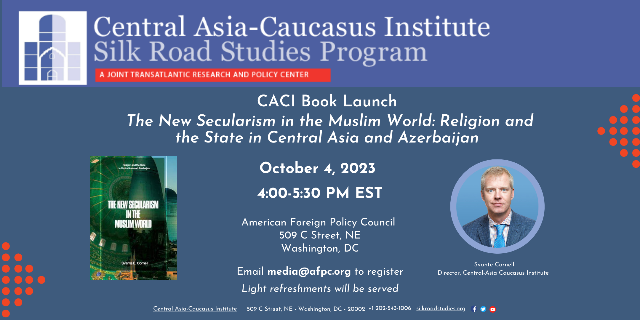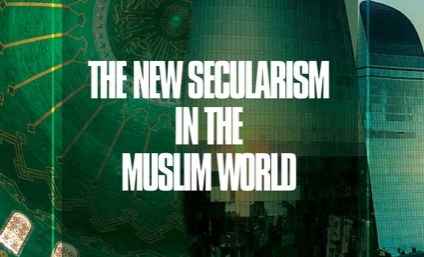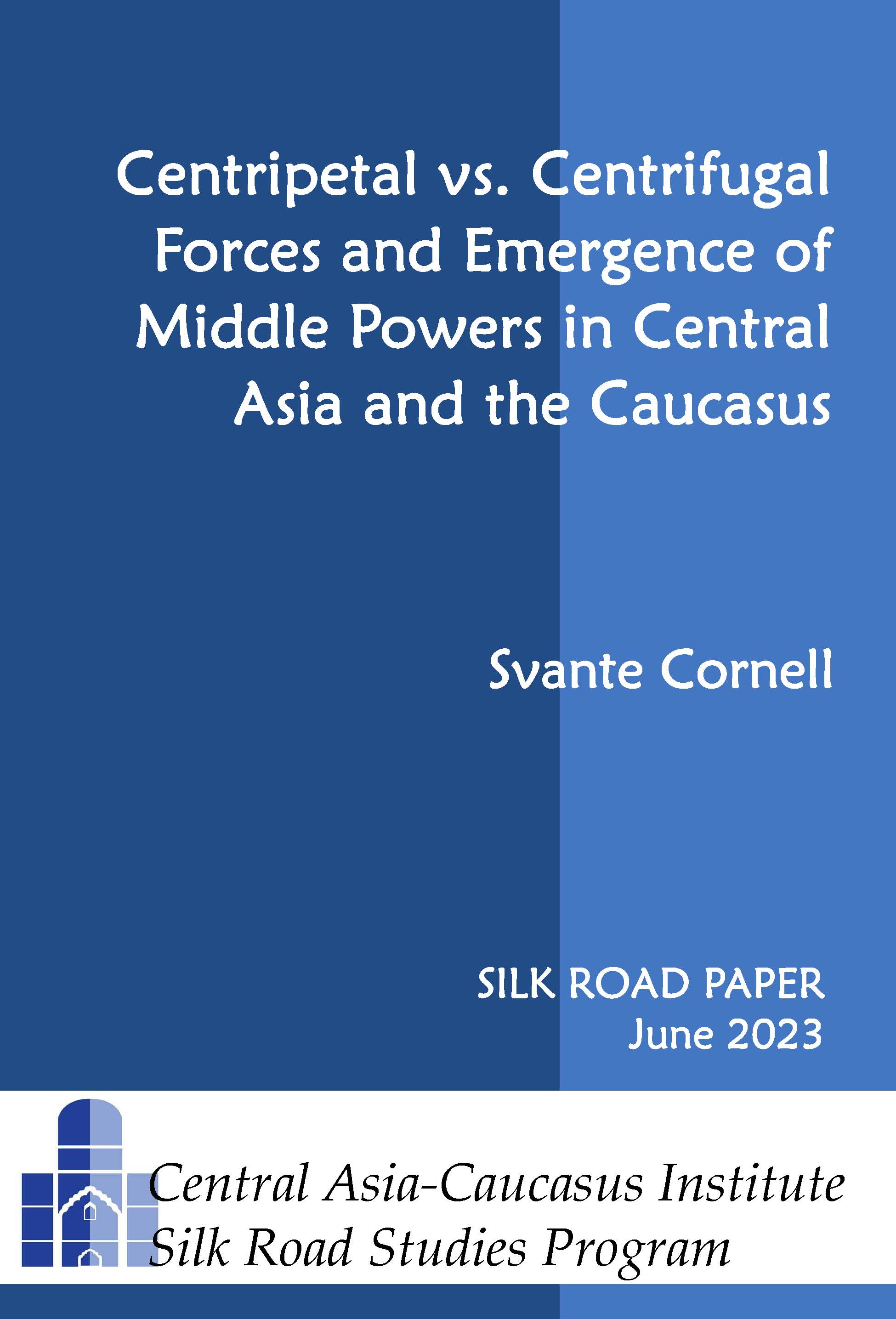A New Spring for Caspian Transit and Trade
 Major recent shifts, starting with the Taliban victory in Afghanistan and Russia’s war in Ukraine have led to a resurgence of the Trans-Caspian transportation corridor. This corridor, envisioned in the 1990s, has been slow to come to fruition, but has now suddenly found much-needed support. The obstacles to a rapid expansion of the corridor’s capacity are nevertheless considerable, given the underinvestment in its capacity over many years.
Major recent shifts, starting with the Taliban victory in Afghanistan and Russia’s war in Ukraine have led to a resurgence of the Trans-Caspian transportation corridor. This corridor, envisioned in the 1990s, has been slow to come to fruition, but has now suddenly found much-needed support. The obstacles to a rapid expansion of the corridor’s capacity are nevertheless considerable, given the underinvestment in its capacity over many years.
10/4 CACI Book Launch: The New Secularism in the Muslim World: Religion and the State in Central Asia and Azerbaijan

Across the Muslim world, religion and politics have become increasingly mixed in the past century, with devastating consequences. But there are signs that the ascendancy of political Islam may be coming to an end. In this context, the experience of Central Asia and Azerbaijan as Muslim-majority states that insist on secular laws, courts and education is a much-overlooked model that is bound to attract greater interest. THE NEW SECULARISM is the first study of the Central Asian model in the realm of the interaction of religion and the state, which examines its characteristics as well as how it relates to other frequently touted models in the Muslim world
Join us for the book launch and a discussion of CACI director Svante Cornell's "The New Secularism in the Muslim World: Religion and the State in Central Asia and Azerbaijan."
WHEN: October 4, 2023 4:00-5:30 PM
WHERE: American Foreign Policy Council - 509 C Street, NE, Washington, DC 20002
The New Secularism in the Muslim World: Religion and the State in Central Asia and Azerbaijan

Centripetal vs Centrifugal Forces and Emergence of Middle Powers in Central Asia and the Caucasus
By Svante E. Cornell
Central Asia-Caucasus Institute & Silk Road Studies Program
Silk Road Paper
June 2023
Executive Summary
 The Russian invasion of Ukraine has drawn renewed attention to the geopolitics of Central Asia and the Caucasus. These are countries that have all faced a variety of assertive or aggressive Russian measures designed to undermine their sovereignty. Their responses have varied, however, both among states and over time. This raises the question of centripetal and centrifugal forces in Central Asia and the Caucasus.
The Russian invasion of Ukraine has drawn renewed attention to the geopolitics of Central Asia and the Caucasus. These are countries that have all faced a variety of assertive or aggressive Russian measures designed to undermine their sovereignty. Their responses have varied, however, both among states and over time. This raises the question of centripetal and centrifugal forces in Central Asia and the Caucasus.
Over the past three decades, internal and external forces seeking to strengthen the sovereignty and resilience of these states have clashed with forces seeking to undermine them. This has led to a growing divergence between stronger and weaker states, as centrifugal forces have come out on top in some countries while centripetal ones have dominated in others. To wit: several states have succeeded in building the institutions of independent statehood, have embarked on efforts to reform sclerotic institutions, have gained a meaningful ability to resist the entreaties of Russia and other regional powers, and are drivers of genuine regional cooperation. Others, by contrast, have seen their statehood compromised, and find themselves in a position where they are frequently unable to resist external pressure. Some lie somewhere in between.
The development of resilience in the region is linked to the social and economic changes taking place across Central Asia and the Caucasus. Countries that were locked into the Soviet system have now opened to the influences of the world, for better and for worse. As a result, a clear divergence has emerged between the Soviet and post-Soviet generations, with the latter considerably more independent of Russian-centric information sources and thinking, and considerably less passive with regards to social and political matters.
While this social development has been largely common across the region, economic development has been vastly divergent. The region has split into oil importers and oil exporters – with the region challenging academic notions of a “resource curse.” Indeed, oil exporters have proven much more resilient against centrifugal forces than oil importers.
This is visible not least in the varying ways through which political and economic change have taken place in the region. In the mid-2000s, “color revolutions” overtook mainly the region’s weaker semi-authoritarian states, generating much hope among well-wishers of democracy in the West. But over time, it became clear that revolutionary change did not succeed in producing sustainable democratic development – either in this region or in the Middle East and North Africa following the 2011 Arab upheavals. Indeed, no country that experienced these upheavals has progressed in a sustainable way toward democracy. Even those that seemed to do so, like Georgia and Tunisia, have visibly backtracked.
By contrast, from 2015 onward another trend has emerged, whereby the leadership in stronger regional countries – Azerbaijan, Kazakhstan and Uzbekistan – have concluded that they can no longer engage in business as usual, and must answer the popular demand for change while seeking to maintain stability. As a result, they have engaged in processes of gradual political, economic and social reforms. None of these reform programs are intended primarily to liberalize the political system or transform these countries into democracies. But they contribute to shifting the logic of the state-society relations from the Soviet model, where the state dominated society, to a modern one where the state’s task is to provide services to society. In so doing, they play a significant role in strengthening the resilience of the political and economic systems.
Meanwhile, these three states have also taken a lead in the development of mechanisms of regional cooperation. In the South Caucasus, the Armenia-Azerbaijan conflict made regional cooperation impossible, and led instead to the formation of trilateral Azerbaijan-Georgia-Turkey cooperation. This began with the major oil and gas pipeline projects connecting the three states, but branched out into a formalized trilateral cooperation format with periodic meetings at the foreign minister and defense minister level, which now includes cooperation in defense industrial development and joint military exercises.
In Central Asia, efforts at regional cooperation in the late 1990s were unsuccessful, being smothered by Russian-led processes of Eurasian integration. Following the shift of power in Uzbekistan that brought Shavkat Mirziyoyev to the presidency, however, a new wind of regional cooperation has swept Central Asia. This was made possible by a greater sense of confidence in countries’ sovereignty and statehood, as well as a greater sense of political and economic urgency resulting from geopolitical competition. Simply put, regional cooperation had become a necessity to avoid great powers dividing and ruling among Central Asian states.
Five years into this new period of cooperation, Central Asian leaders are meeting more frequently than ever, and coordinating policy on various issues in a novel way. They have sought to institutionalize this cooperation, based on international examples like ASEAN and the Nordic Council. Very clearly, Kazakhstan and Uzbekistan have led this process, even going so far as to conclude a treaty on allied relations – a clear signal to outside powers that Central Asians will not be divided by them.
Finally, particularly since the geopolitical situation deteriorated following the U.S. withdrawal from Afghanistan and Russia’s assault on Ukraine, Trans-Caspian cooperation has bloomed. This began even earlier with Azerbaijan and Turkmenistan overcoming long-lasting disagreements on the development of Caspian oilfields. More recently, there has been a major expansion in Azerbaijan-Kazakhstan and Azerbaijan-Uzbekistan ties, complementing the intensification of Kazakhstan-Uzbekistan relations.
Thus, two groups of countries have crystalized in Central Asia and the Caucasus. In one group, centrifugal tendencies remain dominant, making countries weak and vulnerable to a combination of internal and external upheavals. In another, the emerging middle powers, centripetal tendencies have come to dominate, as states have developed an ability to secure their sovereignty and act to preserve it. Importantly the emerging middle powers have paid close attention to cooperation with their weaker neighbors, while also serving as a model for them.
Over the past decade, this disparity has grown clearer. Azerbaijan, Kazakhstan and Uzbekistan have all established themselves as middle powers in part through their internal development, seeking to balance the demand for change from their societies with the imperative of maintaining stability in dangerous times. Their actions on the regional scene have indicated their growing agency: by cooperating with one another and establishing relations with an assortment of foreign powers, they are strengthening their external sovereignty while also helping some of their weaker neighbors avoiding falling into dependence on great powers.
This is not to say that the weaker states totally lack resilience or that there are no vulnerabilities in the stronger ones. As evidenced by Kazakhstan’s January 2022 crisis or the unrest in Uzbekistan’s Karakalpakstan region that summer, all regional states face challenges. Still, the difference is that the emerging middle powers have taken coherent and sustained action to address the deficiencies in the provision of public services, and their leaders have spoken honestly and forcefully about the problems plaguing their government and bureaucracy. They have announced many reforms, but the hard work lies in the implementation of these initiatives, a work that is decidedly one in progress. And going forward, the risk that anti-reform forces will succeed in slowing down implementation is considerable.
The emergence of middle powers is of crucial importance for the region’s future, and for the approaches taken by foreign forces that wish the region well. In short, it means that the notion of this region as a playground of great powers is no longer valid. As the middle powers have sought to devise strategies to prevent the domination of one or another regional power over them, they have also reached out beyond the confines of the region for partners. Seeking to engage East Asian, Middle Eastern and Western powers, the middle powers of Central Asia and the Caucasus are by default partners to the West, sharing a common interest of maintaining what amounts to geopolitical pluralism in the region.
Spring 2023 CAMCA Fellow Presentation: Ripples from Russia's War in Ukraine in the CAMCA Region
Join the spring 2023 Rumsfeld Foundation's Central Asia, Mongolia, the Caucasus and Afghanistan (CAMCA) fellows for a presentation on the regional economic and political implications of Russia's war in Ukraine. Speakers will examine various strategies to better protect their sovereignty, independence and territorial integrity and improve conditions for further economic development. Register for this in-person event to discuss these issues and learn why the U.S. should support the CAMCA countries in this challenging international environment.
Moderator: S. Frederick Starr, Chairman, Central Asia-Caucasus Institute at theAmerican Foreign Policy Council
When: Tuesday April 25, 2023 - 3:00-4:30 PM EST
Where: American Foreign Policy Council, 509 C Street, NE, Washington, DC 20002

